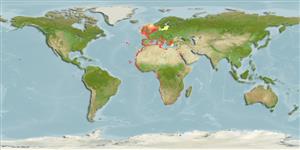Teleostei (teleosts) >
Perciformes/Scorpaenoidei (Scorpionfishes) >
Triglidae (Searobins) > Triglinae
Etymology: Chelidonichthys: Greek, chelidon, -onos = swift, as black as a swift + Greek, ichthys = fish (Ref. 45335).
More on author: Bonnaterre.
Environment: milieu / climate zone / depth range / distribution range
Ecology
Marine; demersal; depth range 10 - 150 m (Ref. 3687), usually ? - 40 m (Ref. 12382). Subtropical; 61°N - 35°S, 32°W - 38°E
Eastern Atlantic: Norway continuously south around Cape of Good Hope to Mozambique. Heemstra 1982 recognizes two valid subspecies, Chelidonichthys lastoviza lastoviza which ranges south to Angola and Chelidonichthys lastoviza africana occurring in South Africa (Ref. 4316).
Length at first maturity / Size / Weight / Age
Maturity: Lm 15.0, range 20 - ? cm
Max length : 40.0 cm TL male/unsexed; (Ref. 3397); common length : 15.0 cm TL male/unsexed; (Ref. 3397); max. reported age: 18 years (Ref. 26321)
Found over rocks and sand, from the coast down to a depth of about 150 m. (Ref. 5213). Feeds on crustaceans (Ref. 12382). Minimum depth from Ref. 12382.
Life cycle and mating behavior
Maturity | Reproduction | Spawning | Eggs | Fecundity | Larvae
Richards, W.J. and V.P. Saksena, 1990. Triglidae. p. 680-684. In J.C. Quero, J.C. Hureau, C. Karrer, A. Post and L. Saldanha (eds.) Check-list of the fishes of the eastern tropical Atlantic (CLOFETA). JNICT, Lisbon; SEI, Paris; and UNESCO, Paris. Vol. 2. (Ref. 3687)
IUCN Red List Status (Ref. 130435: Version 2024-1)
Threat to humans
Harmless
Human uses
Fisheries: commercial
Tools
Special reports
Download XML
Internet sources
Estimates based on models
Preferred temperature (Ref.
123201): 8.9 - 26, mean 11.8 °C (based on 206 cells).
Phylogenetic diversity index (Ref.
82804): PD
50 = 0.5010 [Uniqueness, from 0.5 = low to 2.0 = high].
Bayesian length-weight: a=0.00871 (0.00738 - 0.01028), b=3.03 (2.98 - 3.08), in cm total length, based on LWR estimates for this species (Ref.
93245).
Trophic level (Ref.
69278): 3.5 ±0.5 se; based on diet studies.
Generation time: 3.0 (1.7 - 5.1) years. Estimated as median ln(3)/K based on 11
growth studies.
Resilience (Ref.
120179): Medium, minimum population doubling time 1.4 - 4.4 years (K=0.13-0.65; tm=3; tmax=18).
Fishing Vulnerability (Ref.
59153): Low to moderate vulnerability (32 of 100).
Climate Vulnerability (Ref.
125649): Low vulnerability (6 of 100).
Nutrients (Ref.
124155): Calcium = 107 [56, 257] mg/100g; Iron = 1.36 [0.72, 2.72] mg/100g; Protein = 19.5 [18.0, 20.8] %; Omega3 = 0.568 [0.268, 1.545] g/100g; Selenium = 35 [17, 81] μg/100g; VitaminA = 9.09 [3.29, 24.41] μg/100g; Zinc = 0.746 [0.538, 1.092] mg/100g (wet weight); based on
nutrient studies.
